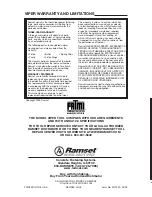
TOOL OPERATION
DAILY FUNCTION TEST
Always check the tool first to make sure
that it does not contain a load strip or
fastener.
Test the tool overhead several
times by completely depressing it on a hard
surface. You should hear an audible click as
the firing pin releases. Let up on the tool and
check to be sure that the barrel assembly
has opened to the starting position.
Next, place the tool, pointing downward, on
a hard surface and firmly, completely depress
the tool. You must not hear the firing pin
release! If the firing pin releases.
STOP, DO
NOT TRY TO USE THE TOOL UNTIL THE
PROPER REPAIRS HAVE BEEN MADE.
Contact your Ramset Distributor for repairs.
OPERATING THE VIPER TOOL
1. Insert a fastener assembly into the
muzzle bushing end of the tool until
it is fully seated. If a clip assembly is
being used, be sure it is positioned in
the cutout section of the spall guard.
2. Insert a load strip into the bottom of the
handle and push it in until your finger is
in firm contact with the handle recess.
Never try to insert a load strip into the
tool from the top of the receiver.
3. Carefully raise the tool to the ceiling
and depress the barrel assembly
where the fastening is to be made.
Hold the tool perpendicular and forc-
ibly push upwards on the pole handle
to compress the firing pin spring and
release the sear to fire the tool.
If the
tool does not fire, continue to hold it
in place for at least 30 seconds and
then follow the misfire procedure on
page 6.
Always point the tool in a safe
direction and use care when raising it
to the ceiling to avoid bumping objects
that could cause the tool to fire.
TOOL OPERATING INSTRUCTIONS
TOOL OPERATING INSTRUCTIONS
9
INSERT FASTENER INTO THE MUZZLE END
OF THE TOOL
INSERT LOAD STRIP INTO THE OPENING IN
THE BOTTOM OF THE HANDLE
RAISE TOOL TO THE CEILING AND DEPRESS
THE BARREL ASSEMBLY. THEN PUSH UP
FORCIBLY AGAINST THE WORK SURFACE
TO FIRE THE TOOL
PERFORM FUNCTION TEST WITH EMPTY,
UNLOADED TOOL
A
B
C
Empty
CHECK
OPERATION
DAILY
FUNCIONAMIENTO DE
LA HERRAMIENTA
Prueba diaria de funcionamiento. Siempre
compruebe primero la herramienta para
cerciorarse de que no contenga una tira
de cargas o elementos de fijación.
Pruebe
la herramienta varias veces elevándola y
presionándola sobre una superficie dura.
Debe oírse un clic en el momento en que
se desengancha el percutor. Retire la
herramienta y compruebe que la boquilla
se ha abierto a la posición de comienzo.
A continuación, coloque la herramienta,
apuntando hacia abajo, sobre una superficie
dura y oprímala con firmeza para hacer que
se retraiga completamente. ¡No se debe oír
el desenganche del percutor! Se el percutor se
desengancha,
DETÉNGASE, NO INTENTE
UTILIZAR LA HERRAMIENTA HASTA
QUE SE HAYA REPARADO EN FORMA
APROPIADA.
Póngase en contracto co
n s
u
distribuidor Ramset para estas reparaciones.
OPERACIÓN DE LA
HERRAMIENTA VIPER
1. Inserte un conjunto de elementos de fijación
dentro del extremo de la boquilla hasta
que esté totalmente asentado. Si se está
empleando un conjunto de clips, cer
ció
res
e
de que esté colocado en la sección co
n
muesca de la guards contra astillas.
2. Inserte una tira de cargas en la parte
inferior del mango y empújela hasta que
el dedo está en contacto firme con el
hueco en el mango.
No intente nunca
insertar una tira de cargas dentro de
la herramienta desde la parte de
arriba del receptor.
3. Levante cuidadosamente la herramienta
hacia el techo y presione el conjunto del
cañón donde se va a realizar la fijación.
Sostenga la herramienta de forma
perpendicular a la superficie elevada y
presione con fuerza hacia arriba en el
mango de la culata para comprimir el
resorte del percutor y soltar el fiador para
dispara la herramienta.
Si la herramienta
no dispara, manténgala en su lugar
durante por lo menos otros 30 segundos,
y continuación siga las instrucciones del
procedimiento de falla de disparo en la
página 6.
Apunte siempre la herramienta
en una dirección segura y tenga cuidado
cuando la levante hacia el techo de que
no la golpee contra algún objeto lo cual
podría ocasionar que se dispare.
INSTRUCCIONES DE OPERACIÓN
DE LA HERRAMIENTA
INSTRUCCIONES DE OPERACIÓN
DE LA HERRAMIENTA 9
INSERTE EL ELEMENTO DE FIJACIÓN
EN EL EXTREMO DE LA BOCA DE
LA HERRAMIENTA
INSERTE LA TIRA DE CARGAS EN
LA ABERTURA EN LA PARTE
INFERIOR DEL MANGO
LEVANTE LA HERRAMIENTA AL TECHO Y
PRESIONE EL CONJUNTO DEL CAÑÓN.
PRESIONE LUEGO CON FUERZA CONTRA
LA SUPERFICIE DE TRABAJO PARA
DISPARAR LA HERRAMIENTA
REALICE LA PRUEBA DE FUNCIONAMIENTO
CON LA HERRAMIENTA VACÍA Y
DESCARGADA
A
B
C
Vacía
VERIFIQUE
DIARIAMENTE EL
FUNCIONAMIENTO
90°
90°


































